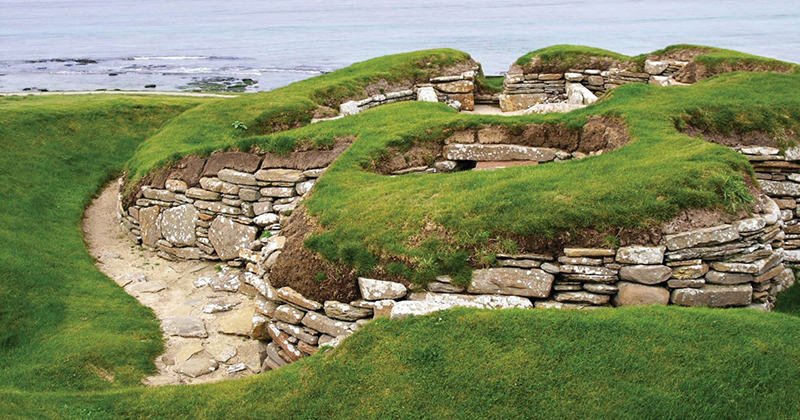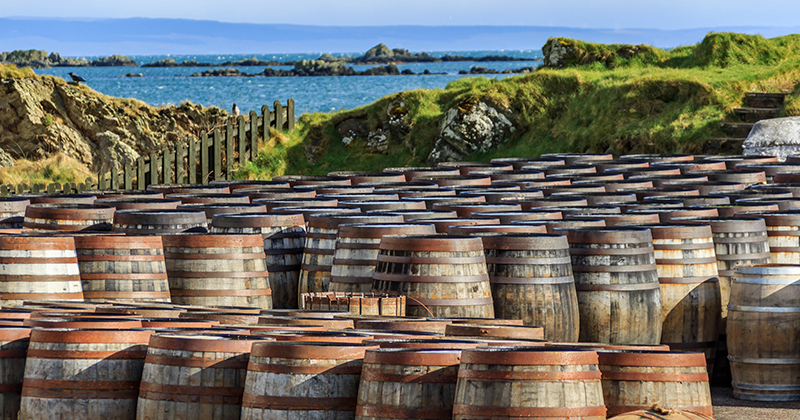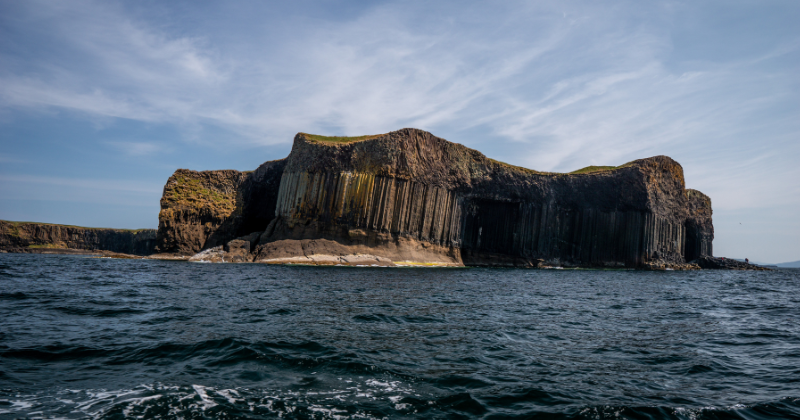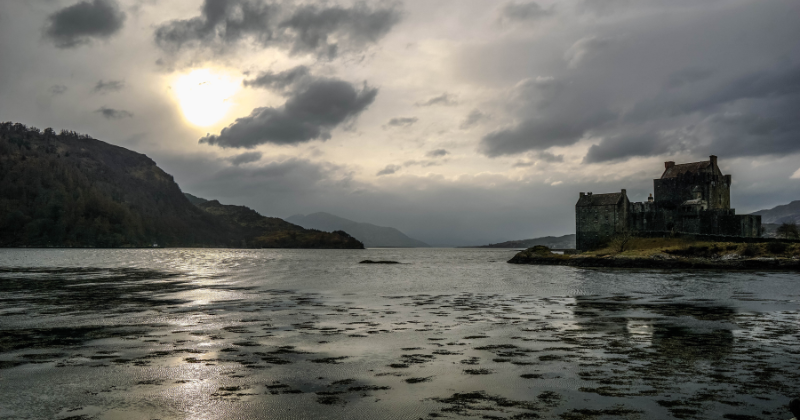
4 Best Remote Places in Scotland to Visit from Edinburgh
Often with a story or two to accompany it, Scotland’s remote locations are often the most intriguing to visit. Promising mythical sites which survived the strongest of storms, famous whisky distilleries, and even mysterious caves which reside on an uninhabited island (that is if you don’t include the puffins)... Yes, Scotland does have a secret side that we’re willing to shed light onto, just for you. But how do you go about finding these hard-to-reach gems? We’ve got our 4 favourite remote locations to get you started on your quest.
Table of Contents:
- Scotland's Remote Nature
Scotland’s Remote Nature
For a wee country, Scotland has many highlights off the beaten path. Part of what makes these distant destinations so tantalising is how difficult they are to reach. But if remote places in Scotland are what you yearn for, then remote places in Scotland are what you shall get. Most likely you’ll start in the capital city of Edinburgh, so we’ve created a guide for you to compare your travel options to some of the most precious but difficult to reach gems in the country. Shall we begin?
Skara Brae

Remote places in Scotland don’t come much more intriguing than Skara Brae. A stone-built Neolithic settlement, Skara Brae is located on the west coast of Orkney. In both 1850 and 1925, the high winds and high tides of great storms stripped away the top layers of grass revealing the outline of stone buildings. After further excavation, a well-preserved community of houses was found. Radiocarbon dating confirmed that people lived here for around 600 years, between 3200 BC and 2200 BC.
Today, Skara Brae is regarded as one of the best-preserved Neolithic settlements in Western Europe. That’s pretty good qualification for one of the best remote places in Scotland if you ask us.
How to Get to Skara Brae:
1. Car
It takes eight hours of non-stop driving from Edinburgh to reach Skara Brae. We did warn you that these were some of the most remote places in Scotland. Once at the top of the Scottish mainland you’ll have to catch a ferry from Scrabster, Gilla Bay, or John O’Groats over to Orkney. Then it’s around a 30-minute drive from Kirkwall to Skara Brae.
- Pros - driving to remote places in Scotland provides you with a lot of freedom to choose your route, when to stop, and for how long
- Cons - flicking through guidebooks can be boring and time consuming. Plus, without correct information it can be hard to know where you should stop along the way. You’ll need to hire a car, pay for fuel, drive on the opposite side of the road (if applicable), and organise a separate ferry journey at the correct time. That’s a lot of faff you’d probably rather avoid.
2. Flight
A flight takes one hour and 15 minutes from Edinburgh to Kirkwall in Orkney. It costs around £250 for a one-way journey.
- Pros – quickest method of getting there
- Cons – you fly over the top of the Highlands, missing all the beauty and world-renowned scenery. Once in Kirkwall, you’ll have to organise hiring a car or use public transport to reach Skara Brae. Because it’s one of the more remote places in Scotland, flights can be expensive and may not be readily available. Also no guide means you learn very little about Skara Brae and Scottish history to add to your enjoyment of the trip.
3. Rabbie's Tour
At Rabbie’s, visiting remote places in Scotland is our bread and butter. We journey to Skara Brae on our 10-day Orkney & the Outer Hebrides tour.
- Pros:
- Along the way, you’ll see Stirling, Glencoe, Inverness, and Kirkwall. After Orkney, you’ll visit the Outer Hebrides and enjoy amazing stone circles, white sandy beaches, and remote castles.
- We’ll organise the driving and ferry for you. Our driver-guides receive live updates of traffic problems so they can take different routes and ensure you have the best experience possible no matter the weather or traffic. You just sit back and relax with a camera in your hand, we’ll do the rest.
- Local knowledge – our driver-guides provide you with lesser-known facts about Skara Brae and Scottish history because we believe in fostering curiosity and revelling in the secrets of a destination.
- Cons - There’re none. We may be biassed but when it comes to visiting remote places in Scotland, there truly is no better way to do it than aboard a Rabbie’s small group tour.
Islay

The Isle of Islay is the southernmost island in the Inner Hebrides of Scotland. Not just one of the most remote places in Scotland but one of the most majestic, it’s not surprising that Islay is known as the ‘Queen of the Hebrides’. Scotch-lovers travel from all over the world to visit its many whisky distilleries. Islay single malt whiskies are some of the strongest flavoured of all malt whiskies because the island’s peaty water is used at every stage of production. Some find this distinct taste endearing, others appreciate it less.
Southern Islay distilleries (Ardbeg, Laphroaig, and Lagavulin) produce medium-bodied whiskies with strong notes of peat-smoke, brine, and iodine. Northern Islay distilleries (Bruichladdich and Bunnahabhain) are unpeated and have much milder notes meaning they taste fruity or creamy by contrast. This is because the water used is straight from a spring before it has had contact with peat. Bowmore distillery is in the middle of the island and shares elements of both northern and southern distilleries. Although it’s one of the most remote places in Scotland, Islay is much more than a sleepy Scottish island.
How to Get to Islay:
1. Train, Bus and Ferry
Catch a train from Edinburgh to Glasgow Queen Street (1 hour 10 minutes). Walk to Buchanan Bus Station and get the 926 bus to Kennacraig Ferry Terminal. This bus only departs 3 times a day (3 hours, 18 minutes). From Kennacraig Ferry Terminal get the ferry to Port Askaig (2 hours). You know it's one of the most remote places in Scotland if it takes three modes of transport to get there.
- Pros – relatively cheap as all public transport combined can cost under £100 to get onto Islay. You can enjoy many drams of whisky if relying on public transport rather than driving yourself.
- Cons – requires you to organise multiple types of public transport, deal with delays, loose change, waiting at stops, and walking in between stations. Once on Islay, you’ll have to hire a car or use the limited public transport to navigate around the island. You also need to decide which distilleries to see (tough choice) and rely on guidebooks to teach you about the island.
2. Car
Driving to Islay from Edinburgh would take over six hours – longer if you account for toilet breaks.
- Pros – you can choose your route and include stops along the way. From the world renowned Loch Lomond to other remote places in Scotland such as the longest inland loch, Loch Awe.
- Cons – drinking alcohol at distilleries and driving is a definite no, so you’ll need a designated driver. But who wants to go on a whisky holiday and not sample the good ol’ stuff?
3. Rabbie's Tour
Another fascinating and remote place in Scotland? Another Rabbie’s tour. Join us on our 8-day Islay, Edinburgh & Speyside Whisky Holiday tour and you’ll be sampling a wee dram of whisky in no time.
- Pros:
- It’s social. By public transport or car you’ll probably have company, but there’s something special about sharing a whisky experience with other like-minded people and toasting to new friendships. It’s also a safe and fun way to visit remote places in Scotland if you’re a solo traveller. Our small group tours have a maximum of 16 people, ensuring a more personal and friendly environment for you to enjoy.
- Throw in some added excitement as we visit extra stops along the way. You’ll stop in Speyside which has more whisky distilleries per square mile than anywhere else. Comparing the peaty Islay whiskies to the sweeter and more citrusy Speyside malts in one trip will leave you feeling like a true connoisseur. We also throw in Edinburgh, Loch Lomond, and the Cairngorms for the lovely scenery.
- There’ll be no drinking and driving. We want you to enjoy exploring the full palette of Scottish whiskies, whilst also staying safe on the roads. Having a scheduled tour means you get chauffeured around Islay without mixing drinking and driving.
- Cons - After you experience this tour there’ll be no going back. You’ll want to spend all your spare time visiting more remote places in Scotland with us.
Fingal’s Cave

Fingal’s Cave is a volcanic sea cave on the uninhabited island of Staffa. Staffa is in the Inner Hebrides of Scotland, west of the Isle of Mull. Despite being one of the most remote places in Scotland, Fingal’s Cave is well worth visiting. Trust us, you’ll agree once you see it for yourself. This geological feature is formed of many volcanic columns of hexagonal basalt rock. It was created by a similar ancient process as Giant’s Causeway in Northern Ireland. Fingal’s Cavegot its name from a poem by 18th century Scots poet-historian, James Macpherson. This island is also renowned for its large colony of puffins who breed there each year. As if you needed any more convincing that this is one of the best remote places in Scotland to visit.
How to Get to Fingal's Cave:
1. Train
To reach this remote place in Scotland, take the train from Edinburgh to Oban. This is usually between a 4 and 5 hour journey. Once in Oban, take a boat trip to Staffa.
- Pros – enjoy nice views from Glasgow to Oban. Spend part of the journey with Loch Lomond and mountains all around.
- Cons – miss out on a chance to stop and properly enjoy the West Highlands. Trains can also be very expensive.
2. Flight
From Edinburgh, catch a bus to Glasgow Buchanan Bus Station (1 hour).Then take another bus to Glasgow Airport (30 minutes). Fly from Glasgow Airport to Tiree (1 hour). Get a sea tour from Tiree to Staffa to see Fingal’s Cave. It definitely qualifies as one of the most remote places in Scotland if it takes two buses, a plane, and a boat to get there.
- Pros – it’s the fastest method of getting to Fingal’s Cave.
- Cons – environmental pollution from a flight. A lot of transport changes, waiting around, airport security, and possible flight delays. Once you reach Staffa, there’re limited options for boat tours from Tiree. You’ll also miss out on seeing other parts of Scotland.
3. Rabbie's Tour
Yes, you guessed it. Fingal’s cave is another one of the remote places in Scotland we can’t resist visiting. In fact we take great pride in showing off this little known Scottish treasure to anybody who’s interested. Join us on our 8-day Islay, Iona, Mull & Skye tour to get an eyeful of this mystical landmark.
- Pros:
- It’s more environmentally friendly than you might think. We operate modern fuel-efficient mini-coaches, which produce a lot less carbon emissions than a flight. We also tax ourselves £10 for every tonne of carbon we use and our whole team votes for which community or environmental projects we spend this money on every year. Read more about our environmental efforts.
- Our driver-guide’s will share their expert knowledge of all the remote places in Scotland with you. Seeing Fingal’s Cave is impressive. But hearing our driver-guides talk about the legends, myths, and stories behind it that inspired many musicians and writers is priceless.
- The stops along the way are for more than just stretching your legs. As part of the journey, you’ll also explore Oban, the ‘Seafood Capital of Scotland’. You’ll visit the whisky distilleries and beaches of Islay. Not to mention we’ll stop at perhaps the most legendary of remote places in Scotland - the Isle of Skye.
- Cons - We’ve said it before and we’ll say it again but there truly are no downsides to visiting remote places in Scotland on our small group tours.
Eilean Donan Castle

Remote places in Scotland don’t get much more far-flung than a castle on an island in a Highland loch. However, this hasn’t stopped thousands of people venturing out to see Eilean Donan Castle. We’re not sure whether it’s in spite of the seclusion or because of it that Eilean Donan is thought of as ‘the most photographed castle in Scotland’. It’s strategically located on Loch Duich at a merging point of three lochs. This Scottish castle has existed here for over 700 years but has been attacked, ruined, and rebuilt many times.
How to Get to Eilean Donan Castle:
1. Car
Four and a half hours of non-stop driving from Edinburgh will get you to Eilean Donan Castle, via the A9 road.
- Pros – freedom to choose your own route, music, and stops.
- Cons – without local knowledge, it’s likely you’ll use the same accommodation/cafés/bars/shops etc. as many other people. This causes queues, traffic congestion, erosion, and prevents money being spread out to remote communities. You also miss out on all stories about the western Highlands if you drive yourself.
2. Rabbie's Tour
You know the drill by now. The best way to visit remote places in Scotland is on a small group tour and our 9-day Iona, Mull, Skye & Orkney tour stops at Eilean Donan Castle. On a shorter time frame? Our Skye & Eilean Donan Castle one day tour may be the perfect adventure for you.
- Pros:
- You’ll support local communities. Using smaller coaches and having expert driver-guides means we can take you to lesser-known attractions and recommend locally owned accommodation. This helps rural communities and protects the environment from too much erosion in one place.
- Extra stops – you can die happy after seeing Eilean Donan Castle, but to truly experience Scotland (and get the best photos for Instagram!), you need to explore the islands like Iona, Mull, Skye, and Orkney. Each island has its own unique character and history which will leave you yearning to find out more.
Explore Scotland and Beyond with Rabbie's
With so many options to get you started, these remote locations in Scotland won’t feel so secluded once you realise how easy they are to access. But why not make things easier for yourself and let us lead the way. After all, with so much to take in, you don’t want to have to keep your eyes on the road. Let our driver-guides take the wheel and you can feel safe in the company you're keeping. For those with keen eyes on other remote Scottish locations, our private tours team are up for the adventure. To stay in the know with everything Rabbie’s, sign up to our mailing list. Delivered directly to your inbox, we share our favourite short stories, our newest departure destinations, and our latest offers including Black Friday travel deals. Don’t miss out.






